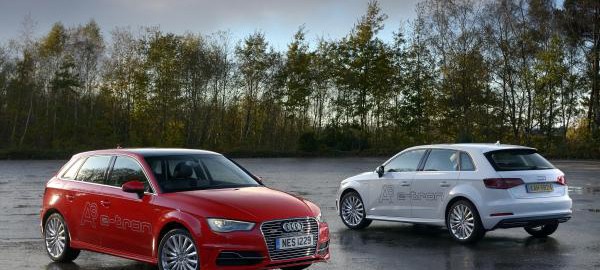THE 2014 World Car of the Year is adding zero emissions motoring to its repertoire with the arrival of the new A3 Sportback e-tron, the first plug-in hybrid to join the Audi range.
Priced from £29,950 (including government grant incentive), the spacious five-door compact hatchback combines a conventional 1.4-litre TFSI petrol engine with an electric motor to deliver impressive performance, exceptional efficiency and, equally crucially, complete freedom from range limitation. The first e-trons will arrive with customers early this year.
At a glance, nothing about the A3 e-tron is new at all. But delve beneath that ubiquitous surface and you will find a very clever petrol-electric hybrid drivetrain that combines the cheap energy of plug-in tech and the ability to recharge on the move. The modified 1.4-litre TFSI unit, in this application featuring a peak power output of 150PS, is linked by a clutch to a 75kw electric motor, which is integrated into a specially developed six-speed S tronic transmission sending power to the front wheels. Combined, the two power units generate 204PS of system power, good for a 0-62mph sprint of 7.6 seconds and a top speed of 137mph. So, it’s no slouch.
Equally importantly, according to the ECE standard for plug-in hybrid cars, the A3 Sportback-based e-tron is capable of covering up to 176.6mpg with CO2 emissions of only 37g/km. With the combination of electric motor and combustion engine, an overall operating range of up to 584 miles is possible.
The Audi A3 e-tron can run exclusively on electric power for up to 31 miles at speeds of up to 81mph, or can be powered by petrol alone. Alternatively, the hybrid mode brings both units into play, and the driver can choose to run these simultaneously – a function known as ‘boosting’ – by initiating kickdown by the S tronic transmission. In this mode the full 350Nm torque output is deployed for the strongest possible acceleration, but when the driver stops accelerating both motors temporarily deactivate, eliminating motor braking torque and allowing the car to glide to conserve fuel and recuperate energy.
Up to medium loads the motor can also function as an alternator, making a significant contribution to retardation and recovering energy which is fed into the traction battery. In this mode the wheel brakes only become active if the driver applies moderate force to the pedal.
The driver has several ways of actively managing the vehicle’s response. Four key settings are available – the EV mode gives priority to electric drive, the hybrid auto mode is useful for long journeys as it engages the electric motor wherever possible, the hybrid hold mode preserves the electrical energy stored in the battery for later use and the hybrid charge mode uses the combustion engine as a generator to charge the battery.
Inside the four passenger doors interior space is good for five, and luggage capacity is the same as a Quattro four-wheel driven A3, which is to say 100 litres down on the basic A3 Sportback and technically only 29 litres more than a Volkswagen Up. It’s broad rather than deep, though, and turns out to be plenty practical enough.
Standard trimmings include LED headlights and daytime running lights, special ‘turbine design’ 17-inch alloy wheels, rear parking sensors, light and rain sensors, MMI navigation plus with hard drive-based mapping and Audi connect online services bringing in-car internet access.
The A3 Sportback e-tron is supplied with two charging leads as standard. One is specifically designed for use at public charging points and the other for domestic use.
The charging lead supplies the car with alternating current from the grid via the charging connection, which is located in the single frame grille behind the fold-out four rings. As well as a status LED, the unit includes two pushbuttons allowing the user to choose between timer-controlled charging and immediate charging.
Using a domestic socket it takes four hours to fully charge the battery. When a wallbox is connected or a public charge point is used this reduces to two hours and fifteen minutes.
The e-tron excels in electric-only mode in city environments, where its is quiet and smooth, but loses something of the dynamics of the regular A3 because of the battery weight beneath the floor. Crucially, the standard everyday hybrid mode does brilliantly well at using the electric motor as much as possible, saving the 1.4-litre turbocharged petrol back-up for more pressing needs and topping up battery charge.
Source: The Northern Echo
